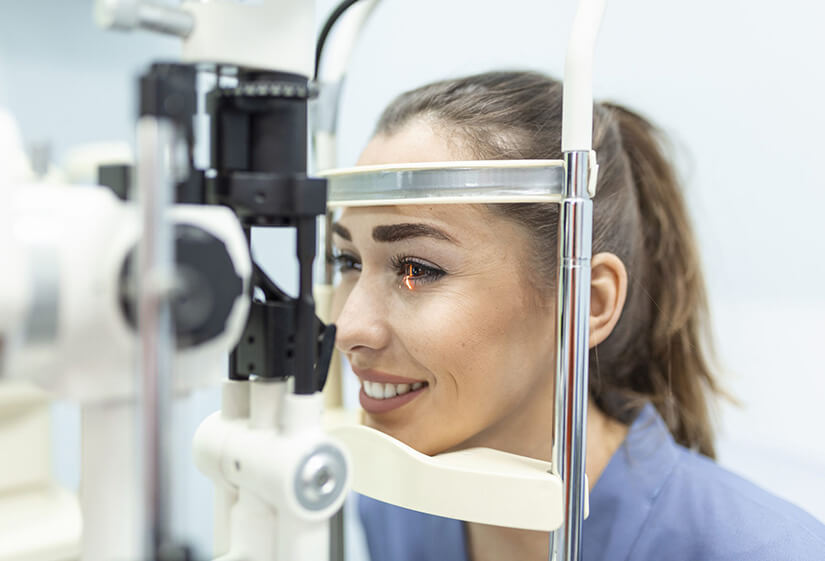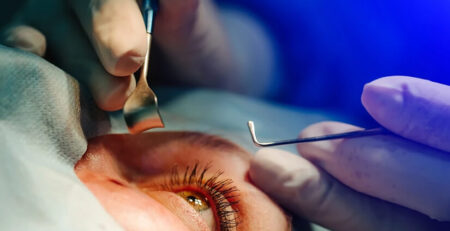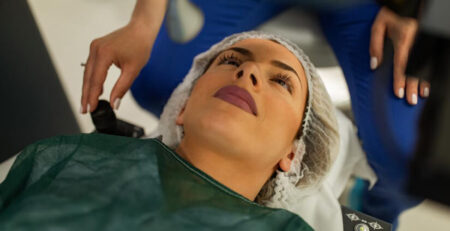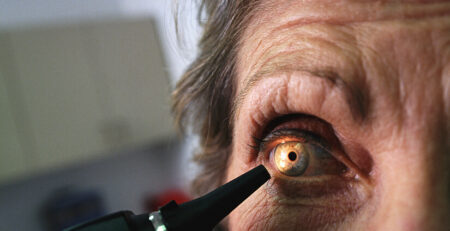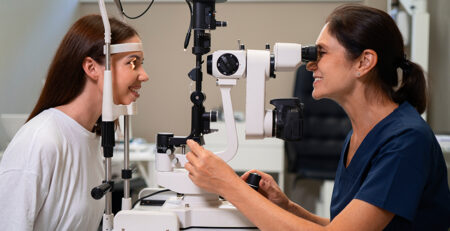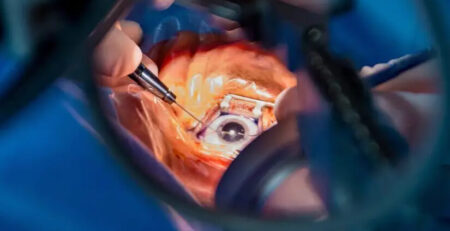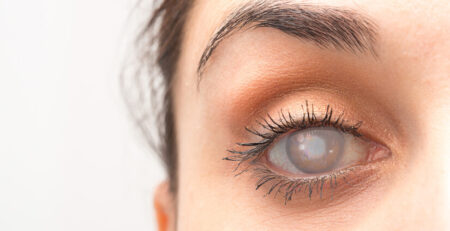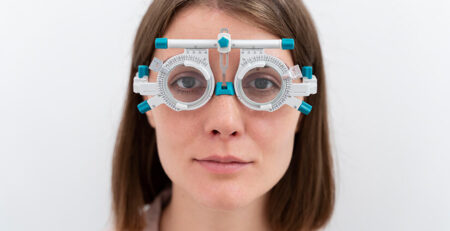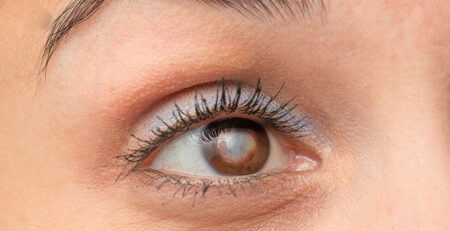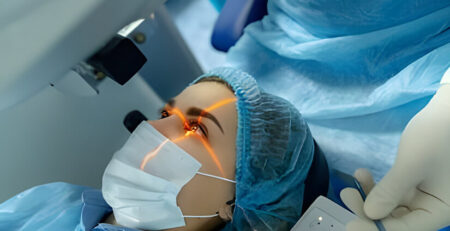Cataract Eye Surgery- All That You Need to Know
Vision is a precious gift that enables us to appreciate the world’s beauty and easily manage life. However, cataracts, a common eye problem, could mask this gift for millions of individuals worldwide, putting a fog over their visual experiences. Cataracts are linked with ageing and can drastically damage one’s quality of life.
In this blog, we will provide you with all the necessary information about what a cataract is, its symptoms, causes, treatment, and how to choose the eye surgeon and hospital for cataract eye surgery.
What is Cataract?
Our eyes have a natural lens that helps to focus the light onto the retina, the light-sensitive tissue at the back of the eye. When cataracts occur, the lens becomes cloudy. In that situation, the light gets scattered, making it difficult to see, drive especially at night and read.
Cataracts are most common in older people. As people age, the proteins in their lenses break down and accumulate in the centre, resulting in a foggy area. This clouding can restrict the light passage on the retina, causing vision issues. Cataracts can occur either in one eye or both eyes.
Different types of cataracts include
Age-related cataracts: As we age, the natural changes of the lens in our eye can lead to the development of a cataract, the most prevalent form. Smoking, consuming alcohol, diabetes, and specific eye procedures like glaucoma surgery can worsen the condition.
Congenital Cataracts: Some people are either born with cataracts or develop them during childhood. The origins of these cataracts can be genetic, linked to intrauterine infections, or some medication and metabolic disorders.
Traumatic Cataracts: Severe eye injuries have the potential to harm the lens, leading to the development of a cataract. This cataract might manifest shortly after the injury or could emerge years down the line.
Secondary Cataracts: Some cataracts occur due to prolonged use of medication like steroids and after eye diseases like uveitis. Eye surgeries like Retinal detachment surgery, macular surgery and glaucoma surgery can also cause premature cataract. These are called secondary cataracts.
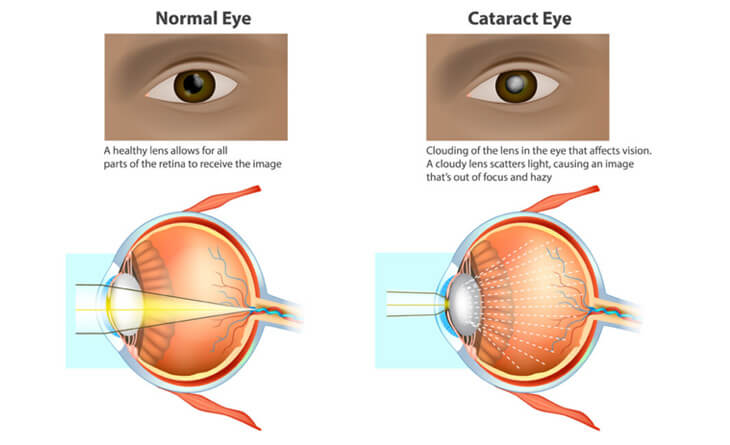
Symptoms of Cataracts
When cataracts are moderate, you may not notice any symptoms initially, but with progression, the symptoms become noticeable and cause vision issues. The most common signs and symptoms of cataracts are
- Cloudy or blurry vision
- Sensitivity to light
- Halos around lights
- Difficulty seeing and driving at night
- Brighter light is required for reading or for other activities
- Difficulty recognising faces
- Increased glare
- Shadowing or haziness in one or both eyes
- Frequent changes in eyeglasses prescription
- Less vivid or yellowed colours
- Double vision

Causes of cataracts
Cataracts arise when protein deposits in the eye’s lens and make it foggy. This prevents light from going easily through. It may cause you to lose your vision. Here are the most common causes of cataracts:
Age: Age is the most significant factor in the development of cataracts. As we age, our bodies go through a sequence of changes. The proteins in our eyes’ lenses degrade and cluster towards the centre, resulting in cloudy spots. This cloudiness leads to cataracts.
Ultraviolet Radiation: Prolonged and excessive exposure to UV rays can lead to the formation of cataracts.
Diabetes: Diabetic patients are at a higher risk of acquiring cataracts. High blood sugar levels might cause cloudiness by affecting the proteins in the lens.
Smoking and Alcohol: Smoking and excessive drinking have been related to an increased risk of cataracts. Tobacco and alcohol can bring toxic substances into the body, damaging the lens.
Certain Medications: Medications like corticosteroids and blood pressure medications might increase the risk of cataract formation.
Eye Injuries or Inflammation: Cataracts can be caused by previous eye injury, inflammation, or operations. Trauma to the eye can produce lens alterations that result in clouding.
Poor Nutrition: A diet deficient in specific nutrients, such as antioxidants (vitamins C and E), may also lead to the formation of cataracts.
Previous Eye Surgery: People who have had eye surgery, such as retinal surgery or glaucoma surgery, may be more likely to acquire cataracts.
Other Health Conditions: High blood pressure, obesity, autoimmune disorders and connective tissue disorders can all raise the risk of cataracts.
Congenital Factors: In some cases, cataracts may occur at birth or develop in childhood due to genetic causes or intrauterine infections.
Treatment of cataract
4a. How is Cataract treated?
Cataract surgery procedure is the most effective treatment option for cataracts. The surgery involves removing the cloudy natural lens and replacing it with an artificial intraocular lens (IOL) to restore clear vision. The IOL is typically made of PMMA, acrylic, or silicone. It remains permanently in the eye and helps to focus light onto the retina for clear vision.
Cataract surgery is usually an outpatient procedure and is performed under local anaesthesia. The most commonly done procedure is phacoemulsification in which small incisions are made on the cornea’s edge to create the opening. After that, an ultrasound probe is used to break the foggy lens. The fragments are then suctioned out, and IOL is implanted in the same place.
Cataract surgery is performed in one eye at a time. If required, the surgeon advises you to wait one to three weeks between surgeries in both eyes. This time gap will help your first eye recover and provide clear vision before the operation on the other eye is performed.
After the surgery, you must follow your surgeon’s instructions carefully for proper healing. During the initial week post-surgery, activities involving heavy lifting and bending should be avoided, and precautions should be taken to prevent water and dust from entering the eyes.
4b. What are the types of Cataract surgeries?
There are several approaches for treating cataracts; however, the fundamental principle centres around phacoemulsification, the most common and safe method of cataract surgery.
Conventional Phacoemulsification: It is the most common cataract eye surgery. During this procedure, your surgeon will make small incisions in the cornea’s edges and introduce a specialised probe through the incision into the cornea. Using ultrasound waves, the probe breaks up the cloudy lens into smaller fragments and removes them through suction. This enables the surgeon to remove the lens in manageable pieces gradually. After removing the clouded lens, the surgeon inserts a new artificial foldable lens into the same place. A very small incision, about 3-3.2 mm, is given to insert the probe. Therefore, sutures are usually not required. The recovery is very fast.
Micro Incision Cataract Surgery (MICS): In this technique, usually, a 2.2 to 2.4 mm incision is made to insert the probe. The rest of the procedure is similar to phacoemulsification. The recovery period is very short in this procedure. Remember, only specific lenses are implanted in this surgery. But a variety of lenses are available.
Femto-Cataract Surgery or Robotic Cataract Surgery: Femto-cataract surgery is an advanced surgery. In this technique, the femtolaser is used to perform a few steps of microincision cataract surgery, like making incisions, creating an opening in the lens capsule and breaking the lens. Then, the surgeon aspirates the lens through ultrasound, and IOL is placed through the same incision. Femto-assisted cataract surgery is performed in very specific cases where the risk is higher.
Small Incision Cataract Surgery (SICS): Small incision Cataract eye surgery (SICS) is a less common surgery; still, it helps to restore vision effectively in some patients. In this technique, a manual long incision is made in the eye to access and remove the cloudy lens. Then, an artificial lens is placed inside the capsule bag. In the end, sutures may or may not be required to close the incision. It is done in specific cases where phacoemulsification is not possible.
4c. Type of Anaesthesia in Cataract Surgery
Cataract eye surgery is an outpatient surgery, and like any other surgical procedure, it is performed under anaesthesia to minimise discomfort. Usually, it is performed under topical or local anaesthesia. However, there are three main types of anaesthesia used for cataract eye surgery:
Topical Anesthesia: Topical anaesthesia is the most common type used for cataract surgery in Delhi. It involves applying numbing drops to the eye. Under this anaesthetic approach, you stay awake during the process, keeping your eyes open and able to look at the microscope light. After surgery, you may or may not need an eye patch.
Peribulbar/ Retrobulbar Block Anesthesia: Retrobulbar block anaesthesia is a type of local anaesthesia that is used for cataract surgery. It involves injecting anaesthetic medication into the space behind the eyeball, which numbs the eye and prevents eye movement during the surgery. The eye needs to be patched for a minimum of 6-8 hours after the surgery.
General Anesthesia: General anaesthesia puts the patient to sleep during surgery. This type of anaesthesia is not commonly used for cataract eye surgery, but it may be used in some cases, such as for patients who are very anxious or who have other medical conditions that make it difficult to use local anaesthesia.
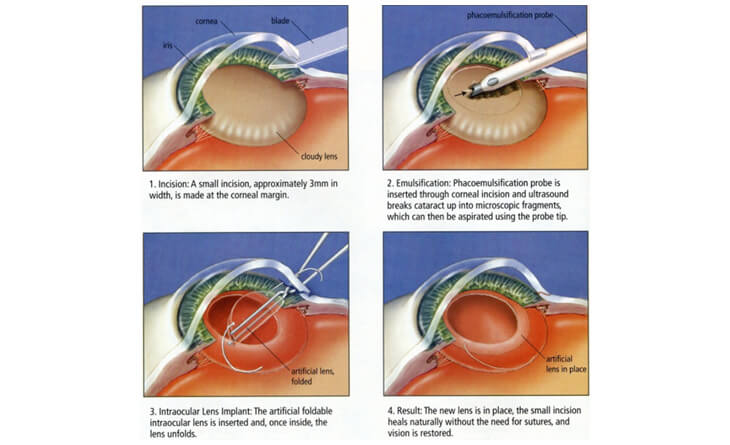
5. What is an Intraocular Lens/ Artificial Lens?
An intraocular lens (IOL) implant is an artificial lens placed into the eye to replace the natural lens, normally removed during surgical procedures such as cataract surgery procedure.
The natural eye lens is a clear part of the eye that refracts light rays, allowing them to focus on the retina and let you see. However, in cataract, the lens becomes cloudy and causes vision problems. Hence, an artificial lens is implanted to replace the clouded lens to restore vision.
There are many different types of IOLs available in the market that are made out of various materials, including acrylic, silicone and PMMA. Your surgeon selects the best IOL material and type for your eyes based on your condition and needs.
5a. Is it necessary to put an Intraocular lens in cataract surgery?
The cornea and the lens are the two optical components directing incoming light onto the retina. The cornea contributes around two-thirds of the entire focusing capability, while the lens contributes the remaining one-third.
During cataract eye surgery, the natural lens of the eye is removed because it becomes cloudy with age. Implanting an intraocular lens in cataract surgery is necessary as it replaces the focusing done by the natural lens. If an Intraocular lens is not put to replace the natural lens , very high-power glasses would be needed to make the vision clear.
5b. What are the different types of Intraocular lenses?
Like prescription eyeglasses and contact lenses, intraocular lenses (IOLs) are also available in different types.
Here are the different types of intraocular lenses:
Monofocal intraocular lenses: Monofocal IOLs are the most commonly used lenses in cataract eye surgery that focus on fixed distances, either near or far. Mostly, the IOL power is selected to make distant vision clear and eyeglasses are needed for reading.
Multifocal intraocular lenses: Multifocal intraocular lenses are designed to give clear vision at different distances, eliminating the dependency on glasses after a cataract surgery procedure. These lenses have many zones for focusing the light at various distances, allowing for improved vision at close and far distances. However, some people may not get adjusted to them due to their side effects like glare and halos, especially at night.
Toric intraocular lenses: Toric intraocular lenses are commonly used to correct astigmatism or cylindrical power, which is caused by an uneven curvature of the cornea. These lenses are required in only specific cases of high corneal astigmatism. Furthermore, they can be monofocal or multifocal.
Extended Depth of Focus intraocular lenses (EDOF): These intraocular lenses are designed to give a continuous range of clear vision from close to intermediate to distant. They function by extending the focus range reducing the need for glasses for different activities. They also are free of the side effects associated with multifocal IOLs and most people adjust well to them. However, they do not make you totally glass free and glasses may still be required for near work.
Accommodative Intraocular Lenses: These intraocular lenses are intended to mimic the natural focusing capacity of the crystalline lens of the eye. They may alter their focus according to the distance of the examined objects, allowing for clearer vision at different distances.
5c. How do I choose which Intraocular lens is suitable for me?
One-size intraocular lenses do not fit all. The best way to choose the suitable lens for your eye is to consult your eye doctor. He/She will examine your vision and prescribe the right lens based on your individual needs. Your ophthalmologist will consider a few factors while selecting the intraocular lens for you.
Age: Younger people are more likely to choose a multifocal or accommodating intraocular lens because they participate in various daily physical activities and want to see clearly at all distances. On the other hand, older people choose a monofocal intraocular lens, as they are already comfortable with using glasses for near work, and do not want to be bothered by side effects such as glare and halos.
Lifestyle: For people with a highly active lifestyle involving activities like driving, office and computer work that demand precise focus, multifocal intraocular lens may be a good option. People with a lot of night driving may not opt for multifocal IOLs due to the side effects of glare and halos.
Cost: The intraocular lens can vary in cost. Monofocal lenses are generally less expensive than other intraocular lenses.
Specific dimensions of the eye: An astigmatism-correcting IOL addresses a distinct issue and is not required in most cases. Similarly, very large or small eyes may need some specific IOLs.
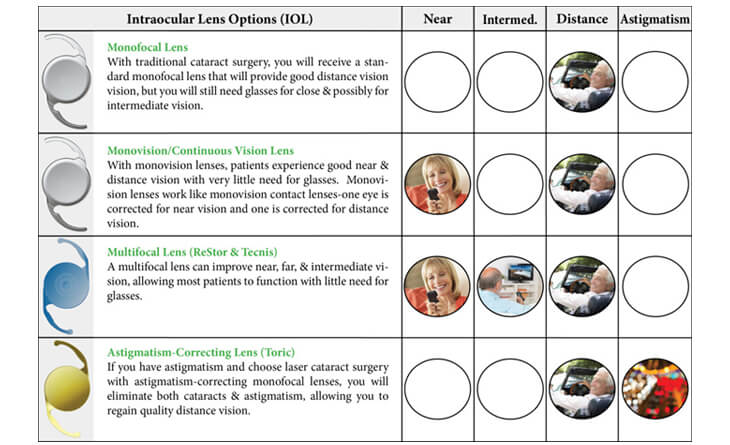
6. Vision After Cataract Surgery
Cataract surgery is a common procedure that involves removing the cloudy lens and replacing it with an artificial lens called an intraocular lens (IOL). The main goal of cataract eye surgery is to improve vision and reduce visual impairment caused by the cataract.
Most patients notice a considerable improvement in their vision after cataract surgery in Delhi. If your retina is fine and your surgery goes fine, you can see clearly after cataract surgery.
Here are a few things you can expect about your vision after cataract surgery in Delhi:
Immediately After Cataract Surgery: Your vision may become fuzzy, and you can experience sensitivity to light immediately after surgery. But these side effects subside within a few days.
1-2 Weeks After Cataract Surgery: Your vision significantly improves, and you can see clearly without eyeglasses. Still, you need to avoid strenuous activities and put eyedrops as prescribed. In this period, things might look brighter than normal, especially in cases of long standing cataract.
1-2 Months After Cataract Surgery: Your vision stabilises, and you can resume your normal daily activities. Glasses if need are generally prescribed in this period.
However, the individual experience can vary based on several factors:
- Type of Intraocular Lens (IOL): Different types of intraocular lenses are used in cataract surgery with their own set of features. Some IOLs are intended to correct distance vision alone, while others are designed to correct distance and close eye. The IOL you choose might influence your vision after surgery.
- Pre-existing Conditions: Other eye conditions like macular degeneration or glaucoma may affect your vision after the cataract eye surgery. Your surgeon will consider these factors when assessing your potential outcome.
- Postoperative Healing: After surgery, your eye requires time to recover. Your vision may be slightly blurry or foggy after surgery, but it should improve as your eye heals over a few days.
- Corrective Lenses: Even after cataract surgery in Delhi, you may require glasses for specialised activities or to adjust your vision, especially if you choose monofocal IOLs with a fixed focal distance.
- Complications: While cataract surgery is safe, some issues like infections, inflammation, or problems with the IOL placement can arise that can affect your vision after surgery.
- Personal Expectations: You must have realistic expectations for the vision after cataract surgery. While most people see a significant improvement in their vision, some might feel initial light sensitivity, glare and reflections that might settle after some time.
7. Precautions and Recovery After Cataract Surgery
Recovery
Cataract surgery in Delhi is considered a safe surgical procedure with a quick recovery. However, the recovery time can vary from patient to patient depending on several factors, such as the type of intraocular lens used, pre-existing conditions, lifestyle and age. The general timeline for recovery after cataract surgery is as follows:
Immediately after surgery: Immediately after cataract eye surgery, you can experience discomfort and blurry vision. You must rest and use prescribed eyedrops to prevent inflammation and infection and control eye pressure.
A few days after surgery: Blurriness in vision during the initial few days is common, as your eye requires time to heal and adapt. Improvement in vision usually becomes noticeable within 2-7 days following the surgery. Additionally, feeling slight itchiness and experiencing mild discomfort for a short period is normal. These side effects are reduced in less than 7 days.
Weeks after surgery: Your vision will improve more; you still need to use glasses for certain activities, but after 2-4 weeks, you can drive, read, and do other activities.
Months after surgery: Your vision will be fully stabilised within 2-3 months. You can perform your daily activities and exercises comfortably like before.
Precautions
After cataract surgery in Delhi, taking proper precautions and following your eye doctor’s instructions are essential for speedy recovery. Here are a few tips that you need to follow for a quick and safe recovery.
- Take proper rest: It is advised to rest properly for at least 2-3 days after cataract surgery and avoid strenuous activities, such as bending over, lifting heavy objects, or exercising.
- Use your eye drops as directed: Your doctor will prescribe eye drops to help prevent infection and inflammation. Use them as directed, even if your eyes feel fine.
- Wear protective glasses: Your eye doctor may recommend you wear protective eye glasses for the first week after surgery to protect your eye from injury and unnecessary rubbing.
- Avoid rubbing your eyes: Rubbing your eyes can irritate your vision and increase your risk of infection. Therefore, avoid touching and rubbing your eyes.
- Avoid swimming: Swimming can introduce bacteria into your eye and increase your risk of infection. Avoid swimming until your doctor instructs.
- Avoid wearing eye makeup: Eye makeup can cause irritation in your eye and increase your risk of infection. Avoid wearing eye makeup.
- Be careful showering or bathing: Bathe below the chin and wipe your face with a wet towel for the first 7 days.
- Driving restrictions: You may need to avoid driving until your surgeon permits you to drive. It would be best to make transportation arrangements because your vision may be cloudy shortly after surgery.
- See your doctor for follow-up appointments: Attend all the follow-up appointments with your doctor for a smooth recovery.
Keep in mind that each person’s recovery process will differ significantly depending on their overall health and the specifics of the procedure. During recovery, always see your surgeon for personalised advice and counselling.
8. What Are the Risks of Cataract Surgery?
Cataract surgery procedure is generally considered safe and highly successful, but like any surgical procedure, it carries potential risks and complications. However, discussing with your eye doctor can help to eliminate these complications. Here are the most common risks of cataract eye surgery:
Infection: While rare, infection can occur after cataract surgery due to the entry of bacteria. You can experience eye pain, redness or sensitivity to light due to infection. In that case, your doctor may prescribe antibiotics to reduce these risks. You may require further surgery to contain the infection.
Inflammation: You may experience inflammation in the eye, which can cause discomfort and affect vision, which can be managed with prescribed eye drops.
Swelling or Edema: Swelling of the cornea, called corneal edema, can also occur immediately after cataract surgery in Delhi which may lead to temporary blurred vision. However, it resolves with time.
Glaucoma: Cataract surgery can occasionally cause a temporary rise in intraocular pressure, which can cause or worsen glaucoma. This can be easily managed with eyedrops.
Retinal Detachment: A cataract surgery may sometimes increase the risk of retinal detachment. However, it occurs very rarely. It requires immediate treatment to avoid visual loss.
Macular Edema: Fluid accumulation in the macula, the core region of the retina, can cause distorted or impaired central vision. This fluid buildup in the eye can lead to decreased vision, which can take up to 2 months to resolve. It can be managed with steroid and nonsteroidal topical treatments. Some cases may need medicines to eat or injections inside the eye.
Astigmatism: Changes in the cornea’s shape during the cataract surgery procedure can cause astigmatism, which may require additional correction with eyeglasses or contact lenses.
Posterior capsule rupture and dislocated cataractous lens: Rarely, the posterior capsule may get ruptured during the surgery and part of the cataractous lens may fall backwards into the vitreous cavity and retina. This may require further surgery to restore your vision.
Dislocated Intraocular Lens: The intraocular lens (IOL) implanted during cataract surgery can rarely shift or dislocate, requiring additional repositioning surgery.
Secondary Cataract: The lens capsule covers the eye’s lens. During cataract surgery ,the capsular bag is left intact and IOl is put inside that bag.. The posterior or back part of the capsule is the place, where the possibility of developing a secondary cataract arises, often referred to as posterior capsule opacification (PCO). This condition can lead to a recurrence of cloudy vision. This is easily managed with a Yag laser that is done in OPD settings.
Dissatisfaction with Vision: While most people experience improved vision after a cataract surgery procedure, not everyone achieves perfect vision. Some may still require glasses for reading or driving.
The risks associated with cataract eye surgery are relatively low, and the potential benefits often outweigh them, especially for individuals whose cataracts significantly impair their vision and daily activities. Consulting an experienced surgeon can help to minimise these risks and ensure a smooth recovery.
9. What is the Cost of Cataract Surgery Procedure?
The actual cost of cataract surgery can vary depending on several factors. The following are the factors that significantly influence the cost of a cataract surgery procedure:
Location of the Clinic: The cost of the medical procedures, including cataract eye surgery, can vary depending on the geographical location of the clinic. Generally, metropolitan cities have higher costs as compared to small towns.
Surgeon’s Experience and Reputation: The surgeon’s experience and reputation can also influence the surgery cost. Surgeons with extensive experience and a strong track record may charge higher fees.
Type of Intraocular Lens (IOL): Various types of intraocular lens (IOL) are available, each with different features. Premium multifocal or accommodating IOLs are usually more expensive than standard monofocal lenses.
Diagnostic Tests and Preoperative Evaluation: Preoperative tests, evaluations, and consultations also impact the surgery cost. Additional diagnostic tests or evaluations might increase the total expense.
Technology Used: Advanced surgical techniques, such as laser-assisted cataract eye surgery or premium imaging systems, significantly impact the cost of the procedure.
Anesthesia and Medications: Anesthesia and medications, like eye drops and eye patches used during surgery and for postoperative care, contribute to the overall cost.
Complications and Revisions: In rare cases, complications during or after the surgery can occur, and additional procedures may be necessary to address the complications. The associated costs will depend on the specific situation.
Consult with your eye surgeon to clearly understand the total cost and what is included in the package. Additionally, inquire about any potential additional costs arising from your specific needs. If you have health insurance, be sure to contact your provider to understand what aspects of the surgery are covered and what your out-of-pocket expenses might be.
10. How to Choose the Eye Surgeon and Hospital for My Cataract Surgery?
Cataract eye surgery is a complex surgery; therefore, finding the best eye surgeon in Delhi and hospital is very essential. Here are a few tips for finding the best eye surgeon and hospital:
Research and Read Review: Start by researching reputable eye surgeons and hospitals in your area. You can use online search engines and read online reviews and testimonials from patients who have undergone cataract surgery procedures with the surgeon and facility you’re considering to compile a list of potential options.
Check the Credentials and Experience of the Eye Surgeon: Look for a board-certified eye surgeon with specialised cataract surgery training. Check her/her experience and the number of cataract surgeries they have performed. Check his/her affiliations with medical associations, academic institutions, and hospitals.
Referrals: You can ask your primary care doctor, friends, family, or other healthcare professionals for recommendations for surgery. Personal referrals can provide valuable insights into the quality of care provided.
Consultations: Make appointments with multiple eye surgeons to discuss your issue and gather information about different surgical methods, the types of intraocular lenses used, and any extra services they give.
Technology and Techniques: Advanced technologies like laser-assisted or premium imaging systems are introduced. Check if the surgeon and the hospital provide advanced facilities or not.
Communication and Comfort: Pay attention to the surgeon’s communication approach during consultations. Select a surgeon who will listen to your concerns, answer your questions, and make you feel at ease. Choose a surgeon who understands your personal needs and makes suggestions suited to your lifestyle.
Second Opinions: Don’t hesitate to seek second opinions if unsure about a particular surgeon treatment plan or hospital. This can help you make a more informed decision.
Cost Consideration: While price is essential, it should not be the only factor influencing your selection. Consider the surgeon’s level of care and skill and the services included in the package.
Cataract surgery procedure is a popular procedure with a high success rate. However, choosing a trained and experienced surgeon and a renowned hospital might increase your chances of a successful outcome. Make an informed selection and select the eye surgeon that best meets your requirements.
Wrapping Up!
Cataract is a common age-related condition that can significantly impact your vision and quality of life. Fortunately, cataract eye surgery has emerged as a safe and effective solution to restore clear vision and enhance daily activities. You can regain your visual clarity by getting the clouded lens removed and getting an artificial intraocular lens implanted.
While cataract surgery is generally low-risk, it’s important to understand the potential complications and recovery process. Following proper precautions, postoperative care instructions, and selecting a skilled surgeon and reputable surgeon are essential steps in ensuring a successful outcome.
If you are considering cataract surgery or have questions about your eye health, consult with Dr. Anisha Gupta, a qualified ophthalmologist. She is dedicated to providing comprehensive eye care and helping patients achieve optimal visual results. Take the first step toward a clearer vision and improved quality of life by scheduling a consultation with Dr Anisha Gupta today.

